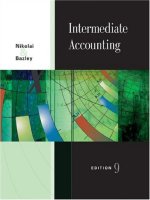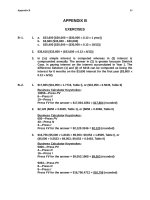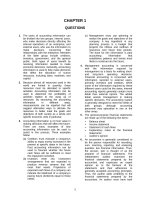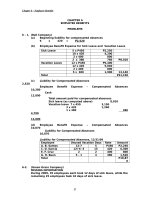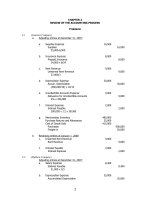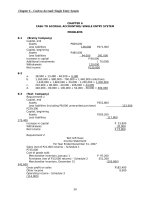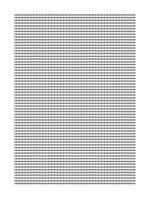Solution manual intermediate accounting by robles empleo ch 6 answers 2008
Bạn đang xem bản rút gọn của tài liệu. Xem và tải ngay bản đầy đủ của tài liệu tại đây (78.14 KB, 6 trang )
Chapter 6 – Cash to Accrual/ Single Entry System
CHAPTER 6
CASH TO ACCRUAL ACCOUNTING/ SINGLE ENTRY SYSTEM
PROBLEMS
6-1
6-2
(Brainy Company)
Capital, end
Assets
Less liabilities
Capital, beginning
Assets
Less liabilities
Increase in capital
Additional investments
Withdrawals
Net income
a.
b.
c.
d.
P609,000
138,000
P471,000
P485,000
94,000
391,000
P 80,000
( 70,000)
120,000
P130,000
38,900 + 13,480 – 48,200 = 4,180
1,160,000 + 980,000 – 700,000 = 1,440,000 collections;
1,440,000 + 1,660,000 + 30,000 – 1,200,000 = 1,930,000
210,000 + 80,000 – 40,000 – 206,000 = 44,000
440,000 – 80,000 + 100,000 + 54,000 – 30,000 = 484,000
6-3
(Text Company)
Requirement 1
Capital, end
Assets
P352,800
Less liabilities (including P8,000 unrecorded purchase)
123,500
P229,300
Capital, beginning
Assets
P293,200
Less liabilities
117,800
175,400
Increase in capital
P 53,900
Withdrawals
20,000
Net income
P 73,900
Requirement 2
Text Gift Haus
Income Statement
For Year Ended December 31, 2007
Sales (net of P21,000 returns) – Schedule 1
P725,000
Cost of goods sold:
Merchandise inventory, January 1
P 97,200
Purchases (net of P13,000 returns) – Schedule 2
551,200
Merchandise inventory, December 31
(105,800)
542,600
Gross profit on sales
P182,400
Other income
8,000
Operating income – Schedule 3
(114,000)
30
Chapter 6 – Cash to Accrual/ Single Entry System
Operating income
Interest expense
Net income
Schedule 1 – Sales
Receipts from customers
Accounts receivable, beginning
Accounts receivable, ending
Accounts written of
Sales returns
Gross sales
P 76,400
( 2,500)
P 73,900
P697,500
( 59,400)
76,100
10,800
21,000
P746,000
Schedule 2 – Purchases
Payments to trade creditors
Accounts payable, beginning
Accounts payable, ending
Unrecorded purchases
Purchase returns
Gross purchases
P536,600
( 63,300)
69,900
8,000
13,000
P564,200
Schedule 3 – Operating expenses
Bad debts expense
Depreciation expense (85,000 + 20,000 – 95,500)
Other operating expenses:
Payments for operating expenses
Prepaid expenses, beginning
Prepaid expenses, ending
Accrued expenses, beginning
Accrued expenses, ending
Total operating expenses
6-4
P 10,800
9,500
P94,100
6,000
( 7,500)
( 4,500)
5,600
P 114,000
(Best Fastfood)
Best Fastfood
Income Statement
For Six Months Ended December 31, 2007
Sales
P2,100,000
Cost of sales:
Purchases
P1,850,000
Less Inventory, end
450,000
1,400,000
Gross profit
P 700,000
Depreciation expense
( 24,000)
Other operating expenses
( 556,000)
Net income
P 120,000
Best Fastfood
Balance Sheet
December 31, 2006
Assets
Liabilities and Capital
Current Assets
Current Liabilities
Cash
P 24,000
Accounts payable
P230,000
Accounts receivable
200,000
Bank loan
200,000
Inventory
450,000
Total
current
liabilities
P430,000
Total current Assets
P674,000
Non-current Assets
Tom Cruz, Capital
31
Chapter 6 – Cash to Accrual/ Single Entry System
Equipment
P400,000
Initial investment
P500,000
Less accum. Depr 24,000
376,000
Add net income
120,000
620,000
Total assets
P1,050,000 Total liabilities and capital
P1,050,000
Computation of cash balance:
Cash receipts from:
Initial investment by owner
P 300,000
Collections from sales
1,900,000
Bank loan
500,000
P2,700,000
Less cash payments for:
Purchases
P1,620,000
Bank loan
300,000
Equipment
200,000
Cash operating expenses
556,000
2,676,000
Cash balance, end
P 24,000
6.5.1 (Kenny Rogers Corporation)
(Cash Basis)
Kenny Rogers Corporation
Income Statement
For the Years Ended December 31, 2006 and 2005
Revenues
Expenses
Net Income
2006 sales = P160,000 + 355,000 = 515,000
2005 sales = 295,000
2006 expenses = 67,000 + 160,000 + 45,000 = 272,000
2005 expenses = 185,000 + 40,000 = 225,000
2006
P 515,000
272,000
P 243,000
(Accrual Basis)
Kenny Rogers Corporation
Income Statement
For the Years Ended December 31, 2006 and 2005
Revenues
Expenses
Net Income
2006 sales = 355,000 + 90,000 = 445,000
2005 sales = 295,000 + 160,000 + 30,000 = 485,000
2006 expenses = 40,000 + 160,000 + 55,000 = 255,000
2005 expenses = 185,000 + 67,000 + 25,000 = 277,000
6-6
2006
P445,000
255,000
P190,000
2005
P295,000
225,000
P 70,000
2005
P485,000
277,000
P208,000
(Jill and Jenni)
Jill and Jenni
Income Statement
For the Year Ended December 31, 2007
Cash Basis
Sales
P750,000
Cost of Sales
( 892,500)
Salaries Expense
( 96,000)
Rent Expense
( 60,000)
32
Accrual Basis
P1,057,500
( 637,500)
( 126,000)
( 20,000)
Chapter 6 – Cash to Accrual/ Single Entry System
6.5.2
Other Operating Expenses
Profit
(Atty. D Macapanalo)
( 84,000 )
P(382,500)
(104,000)
P 170,000
Atty. D Macapanalo
Income Statement
For the Year Ended December 31, 2007
Professional Fees
Expenses
Profit
P
P
Professional Fees
2007 Collection
Fees Receivable, January 1
Fees Receivable, December 31
Unearned Fees, January 1
Unearned Fees, December 31
Professional Fees, Accrual Basis
(
Expenses
2007 Payments
Accrued expenses, January 1
Accrued expenses, December 31
Prepaid expenses, January 1
Prepaid expenses, December 31
Expenses, accrual basis
6.5.3
1,242,200
727,300
514,900
P1,250,000
52,000)
47,000
26,200
( 29,000)
P 514,900
P 722,400
( 18,000)
21,500
6,400
( 5,000)
P 727,300
(Jack and Jill Company)
Jack and Jill Company
Income Statement
For the Year Ended December 31, 2007
Sales
Cost of sales
Gross Profit
Other operating income
Gain on sale of automobile
Total income
Operating expenses
Depreciation
Others
Total expenses
Profit before interest
Interest expense
Profit
P
P
7,440,000
4,670,000
2,770,000
P
20,000
2,790,000
P
298,667
1,003,600
1,302,667
1,487,733
104,000
1,383,733
Jack and Jill Company
Statement of Changes in Equity
For the Year Ended December 31, 2007
Jack
P1,750,000
(500,000)
691,867
Equity, January 1
Withdrawals
Share in profit
33
Jill
P1,815,000
(250,000)
691,866
Chapter 6 – Cash to Accrual/ Single Entry System
Equity, December 31
P1,941,867
P2,256,866
Jack and Jill Company
Balance Sheet
December 31, 2007
Assets
Current Assets
Cash
Accounts receivable
Allowance for bad debts (60,000 – 17,500)
Receivable from employees
Deposit on merchandise purchases
Merchandise inventory
Prepaid insurance
Total current assets
Non-current Assets
Property, plant and equipment
Furniture and fixtures
Accumulated depreciation – furniture and
fixtures
Automobiles
Accumulated depreciation - automobiles
Total property, plant and equipment
Total Assets
Liabilities
Current Liabilities
Accounts Payable
Accrued Expenses
Bank loan, including accrued interest
Total current liabilities
Equity
Jack
Jill
Total partners’ equity
Total liabilities and partners’ equity
Sales
Collections in 2006 (6,500,000 -60,000)
Accounts receivable, end (1,800,000 – 17,500)
Write of
Accounts receivable, January 1, 2007
Sales
P
P
P
P
P
P
P
P
P
736,000
1,782,500
(42,500)
30,000
75,000
3,750,000
8,000
6,339,000
220,000
(87,000)
940,000
(421,667)
651,333
6,990,333
1,875,000
16,600
900,000
2,791,600
1,941,867
2,256,866
4,198,733
6,990,333
P6,440,000
1,782,500
17,500
( 800,000)
P7,440,000
Purchases
Payments to merchandise creditors
P4,500,000
Accounts payable, end
1,875,000
Returned merchandise (to be applied to future purchases)
(
75,000)
Accounts payable, beginning
(1,380,000)
Net purchases
P4,920,000
Cost of sales
Inventory, beginning
Net purchases
Inventory, end
P3,500,000
4,920,000
( 3,750,000)
34
Chapter 6 – Cash to Accrual/ Single Entry System
Cost of sales
Depreciation expense
On old furniture and fixtures (P220,000/10)
On old automobiles (P780,000 – 280,000)/ 3
On new automobile 440,000 / 3 x 9/12
Depreciation expense
P4,670,000
P 22,000
166,667
110,000
P 298,667
Expenses other than depreciation
Payments for selling and general expenses
Prepaid insurance, beginning
Prepaid insurance, end
Accrued expenses, beginning
Accrued expenses, end
Expenses other than depreciation
P1,000,000
15,000
( 8,000)
( 20,000)
16,600
P1,003,600
Interest Expense
On bank loan obtained on 01/02/06 and paid 05/02/06
Accrued on bank loan obtained on 05/01/06
Total interest expense
P
P
32,000
72,000
104,000
MULTIPLE CHOICE QUESTIONS
Theory
MC1
MC2
MC3
MC4
MC5
D
A
C
A
D
MC6
MC7
MC8
MC9
MC10
B
C
A
A
C
Problems
MC11
D
MC12
MC13
MC14
MC15
MC16
MC17
MC18
A
D
B
A
D
D
A
MC19
MC20
MC21
MC22
MC23
MC24
A
B
D
B
C
C
MC25
A
MC26
MC27
C
B
210,000 – 50,000 = 160,000 capital, end; 260,000 – 60,000 =
200,000 capital beginning; 160,000 – 200,000 = 40,000 decrease
in capital + 50,000 – 12,000 = 78,000 net loss.
(80,000–4,000) + (120,000– 6,000+ 40,000 – 30,000) = 200,000
800,000 + 320,000 + 124,000 – 240,000 – 96,000 = 908,000
189,000 + 12,000 – 8,000 + 36,000 + 7,000 – 10,500 = 225,500
30,000 + 3,000 – 21,000 = 12,000 + 60,000 – 58,000 = 14,000
600,000 + 400,000 – 200,000 + 300,000 – 150,000 = 950,000
794,000 + 51,000 – 45,000 = 800,000
715,000 – 144,000 – 96,000 – 7,000 = 468,000 + 60,000 – 33,000
= 495,000
800,000 – (144,000/45%) = 480,000
890,000 – 270,000 – 600,000 – 60,000 + 130,000 = 90,000
310,000 + 85,000 + 4,000 + 66,000 = 465,000
280,000 + 67,000 + 5,000 = 352,000
352,000 – 5,000 – 21,700 = 325,300
45,000 + 3,500 + (200,000 x 2%) + (4,000/20% = 20,000 x 5%) =
53,500
45,000 + 280,000 + 140,000 – 110,000 = 355,000 + 10,000 +
50,000 – 60,000 = 355,000
800,000 – 96,000 + 124,000 + 320,000 – 908,000 = 240,000
2,000,000 + 960,000 + 100,000 + 800,000 + 120,000 + 320,000 –
400,000 – 1,600,000 + 1,200,000 + 2,000,000 = 5,500,000
35

